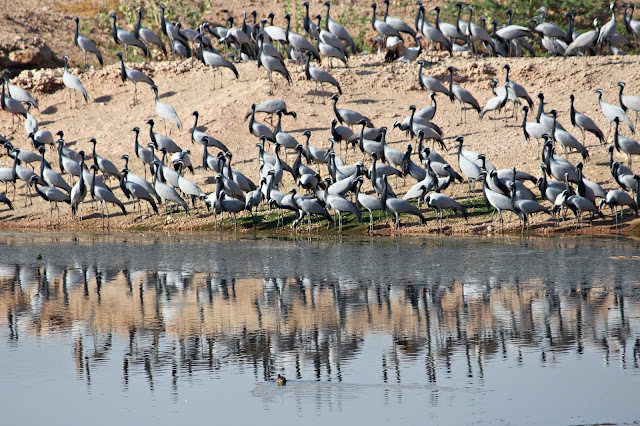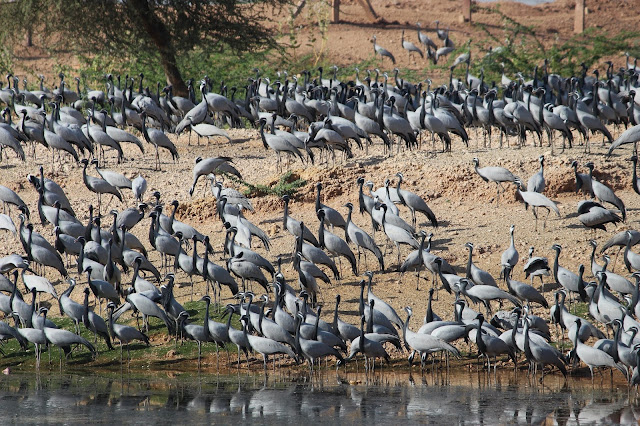I lived in Jodhpur for beautiful six years of my life. I glowed and thrived in the Sun of the Suncity, immersed myself in the history and romance of the Royal sagas, shimmered in the cultural hues, danced to the Langas’ and Manganiyaars’ rhythms and yet missed out on hopping next door to meet these dainty yet brawny visitors from Siberia. Yes, I did not get a chance to go birding to Khichan. Now after thirteen years of migrating to another state, I travelled back to Marwar to meet these migratory birds - I guess because now we both fall in the same category!!
Kurjan or Koonj is as much a part of Rajasthan as is the peafowl. Songs are written and sagas are sung around these beautiful birds whose calls, they say evoke a sense of longing; longing for the union with the beloved who has travelled far in search of a livelihood, longing for a visit home, longing for meeting a long lost friend.
About Demoiselle Cranes
Kurjan or the Demoiselle Cranes (Grus virgo) are a species of cranes from Siberia, who every year travel some 4-5 thousand kilometres to come to Khichan near Phalodi in Marwar region of Rajasthan, to spend the winters in a more favourable weather than the harsh one back home; though now their average length of stay is around eight months, starting from August to the March of next year. Smallest of the cranes, they measure some 33-40 inches in height with a wing span of 61-71 inches. A slender white neck has a dark plumage in the front that runs down to the chest of the bird, thus giving it a maiden like appearance. No wonder then that Queen Marie Antoinette christened them “The Demoiselle Cranes”! Delicate and lady-like in appearance, Kurjan (with a nasal sound in the pronunciation) have pretty powerful wing muscles that help them fly over 4000-5000 kilometres or even more, from Siberia, Russia, Mongolia, China to Rajasthan, Gujarat and some other places in India as well as a few locations in Pakistan.
About Khichan
A quaint little village, just 3.5 km from the nearest town of Phalodi and a mere 139 km from the nearest airport- Jodhpur, Khichan is a village of Jain settlement. Jainism preaches an inclusive way of non-violent living. Jains, like most other communities as well, feed animals and birds around their homes. You would notice a lot of bird-feeding towers in Jain villages.
One can take a train also to reach Khichan via Phalodi. Other option is to fly to Jodhpur or Udaipur and drive down to Khichan. There are some decent places to stay in Phalodi in case you wish to stay the night and revisit the birds the next morning. Mostly, a day excursion from Jodhpur is preferred.
Atithi Devo Bhava in the true sense of the word
In the 1970s, Ratanlal Maloo who was working in Odisha but returned to Khichan after losing his job there, was assigned the task of feeding the pigeons every day in the village. Ratanlal and his wife diligently spread the bird-feed twice every day, at a designated spot. Many birds would come there to feed including pigeons of course, sparrows, parrots, peacocks, some squirrels etc. One fine morning, in a year not identified but sometime in the 70s, Ratanlal noticed a few new visitors who definitely looked like “foreigners”. As is the culture in India, guests are always welcome and so Ratanlal started feeding these visitors too. With around a dozen birds the first time, the number of the migrating visitors grew to over 30,000 during the last year! Noticing the birds being attacked by village dogs, Ratanlal requested for allotment of a separate land, on the outskirts of the village to be fenced and demarcated as a separate “Chugga-ghar” or bird-feeding house. And thus came by the world famous Demoiselle Crane inhabitation into existence. Initially it was the villagers’ efforts and resources, including monetary assistance to keep the bird feeding pond and ground well, but now a few NGOs and other organisations have joined hands too in raising the funds for the upkeep and bird-feed.
Distinct characteristics
Demoiselle Cranes are family oriented birds and usually fly in rectangular formations with the mother leading the flight, followed closely by her young ones with the father trailing behind as a guard. Large groups fly together while migrating or even while shifting their resting spots.
The birds are fed twice a day and after feeding, the birds move to water-bodies, ponds and dunes nearby, only returning to the feeding spot for a drink of water later in the afternoon.
A hop and skip dance can be seen as an expression of affection among couples. The cranes go to nearby farmlands for roosting and return to the feeding spot the next morning.
Their migratory formations have been imitated by the infantry in various battles. There is a mention of the “Koonj formation” being adopted by both the warring sides in the Mahabharata, on the second day of the Kurukshetra war.
The throaty trumpet-like call of the Koonj has inspired many songs and references in the daily lives of people around Khichan.
Why visit Khichan?
Number one reason, of course is a date with these dainty mademoiselles and another important reason is to see how a small village and its people fiercely protect this endangered species of cranes. Little children in the age range of 5-13 years old will surprise you with their knowledge about the cranes. Do take a little help from these little guides and let them earn a deserved pocket money :)
Happy birding!










The Earth belongs to many and humans are just one of them. Thanks for penning such a beautiful story that enables one to see the positives during the ongoing times of distress.
ReplyDeleteCrisp and engrossing.